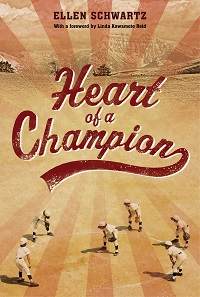| ________________
CM . . .
. Volume XXII Number 19. . . .January 19, 2016
excerpt:
Ellen Schwartz's Heart of a Champion is, on one level, a story about a younger brother who saves his brother. Key to the novel, however, is the World War II setting and the background of the central characters. Set in 1941-2, Heart of a Champion has as its larger theme the expulsion and internment of British Columbia's Japanese Canadians. When the novel opens, nine-year-old Kenny (Kenjo) Sakamoto is living in Vancouver with his family. His father, a First World War veteran, owns a camera shop while his mother is a homemaker. Kenny has a younger sister, Sally, and an older brother, 16-year-old Mickey (Mitsuo), a baseball star. Mickey plays on the Vancouver Asahi baseball team, a club of Japanese-Canadian players, and receives much adulation from sports fans and nubile young women. As Schwartz explains in an author's note, the Asahi club, founded in 1914, dominated baseball in Vancouver, winning the Vancouver International League championship in 1919, and five Pacific Northwest League championships in a row, from 1937 through 1941. December 7, 1941, sets in motion a drastic change in the lives of the Sakamotos and other Japanese Canadian families. As the novel begins, Kenny's heart's desire is to become a baseball star like Mickey. He isn't allowed to participate in phys. ed. or in strenuous activities because his doctor thinks he "may" have a heart murmur. (In 1941 the technology for a more definite diagnosis didn't exist.) Secretly, he persuades Mickey to practise baseball skills with him. World War II begins to affect Kenny when a classmate calls Kenny's friend, Susana Bernstein, a "Kraut”. Kenny gets into a fist fight in Susana's defence. In a class discussion, the children learn that not everyone who lived in Germany was a supporter of the Nazis. Susana explains that, while her family did come from Germany, they are against the Germans because they are Jews:
Here, Schwartz shows talent as a writer for bringing in the war theme in a natural way in terms that nine to twelve-year-olds can understand. This scene also foreshadows the fate of the Japanese-Canadians and implies a comparison between the plight of the Jews in Germany and that of the Japanese-Canadians. Some adult readers may find that comparison jarring or, at the very least, thought-provoking. In making young readers aware of the Japanese-Canadians' suffering during the Second World War, Heart of a Champion is more effective than Joy Kogawa's Obasan because its style is simpler (no stream-of-consciousness) and its organization more linear, with fewer flashbacks. Schwartz presents the steps taken against the Japanese-Canadians as Kenny experienced them. Prior to Pearl Harbor, Japanese-Canadians were not accepted into the armed forces as they had been during the First World War - a development that Kenny scarcely takes note of. After the attack, the Japanese community publicly condemns it, but, as the journalist Mr. Watanabe, warns, "We can protest Japan's actions all we want, my friends, but it won't do any good. This attack means trouble for us." When everyone of Japanese background is required to register as an enemy alien, Kenny begins to worry. Next comes a curfew. Kenny is terrified when men between 18 and 45, including Mr. Sakamoto, are removed from a "one hundred mile wide secure zone along the west coast of British Columbia" and taken to work camps in the BC interior. Next comes the nightmare of being sent to internment camps. The Japanese-Canadians' possessions, including homes and furniture, are held by the Custodian of Enemy Alien Property. Schwartz excels in making elements in Heart of a Champion serve several purposes at once. The Bernsteins' presence in the novel serves several functions. They show that friendship can transcend cultural differences. They provide the Sakamotos with a place to store their worldly possessions when forced to move to an internment camp in the BC interior. Having Susana as a "supporting actor" in a novel with a male protagonist encourages girls as well as boys to read the book. Kenny's and Susana's correspondence provides a means of presenting Kenny's thoughts and keeps readers abreast of events in Vancouver:
Mickey, seemingly the strongest family member, folds under the weight of events. On seeing the internment camp shack that his family must share, he tries to smash the door frame, injures himself and faces arrest for "destroying government property and engaging in riotous behaviour". Thanks to the intervention of the sensei (teacher) Mickey is hospitalized but falls into a depression. In contrast, Mrs. Sakamoto and the other women work together to improve primitive living conditions and organize activities. Little Sally finds an unexpected mentor for her passion, dancing. Kenny's alleged heart murmur is forgotten as he carries water and performs other chores. Eventually he comes up with an activity which unites the boys in the camp and gives Mickey something to live for. Schwartz ends the novel, not in 1945 with the bombing of Hiroshima and Nagasaki, but with the celebration of Kenny's achievement at the internment camp. She has left herself plenty of scope to write a sequel. Heart of a Champion could serve as a model for any aspiring writer of juvenile historical fiction. Highly Recommended.
Ruth Latta has just finished writing a teen novel based on an event in Canadian history. For more information about her books, visit her blog at http://ruthlattabooks.blogspot.com
To comment on this title or this review, send mail to cm@umanitoba.ca.
Copyright © the Manitoba Library Association. Reproduction for personal use is permitted only if this copyright notice is maintained. Any
other reproduction is prohibited without permission.
CM Home |
Next Review |
(Table of Contents for This Issue - January 19, 2016.)
| Back Issues | Search | CM Archive
| Profiles Archive |
